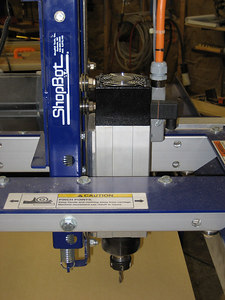Last month I said I was going to experiment more with V-bits and tell you what I have learned. Well, that project is still in the works and I hope to have information by next month.
The big excitement in the shop for February was upgrading my Porter Cable router to a 4HP HSD spindle. My reason for doing this was to lower the noise level in the shop, improve my cutting speed and increase my quality of cuts. Well I am happy to report the work to make this change was quick and painless. There were no unexpected things to fix or problems to work out. It was quite anti-climatic in fact. When I powered on the VFD for the first time and brought life into the new spindle, this grand event was heralded only by a quiet whisper of the cooling fan perched on top of the spindle. No bangs, whirrs, clunks, thuds or screams. Just peaceful quiet rotational bliss. I can now hear the song of the stepper motors as my machine munches its way through the day.
 Router
|
 Spindle
|
As well as installing the spindle, I also added four V rollers to my Z axis like the PRTalpha machines have. I thought this was going to be a real problem as the nuts need to be placed on bolts that are way down in the square tube that makes up the Z axis. This too turned out to be an easy task, as did getting all eight rollers to line up.
The VFD that ShopBot packages with the HSD spindles will only display frequency, not RPM. This is no big deal, and with a second or two in Excel, I had a nice chart to fix to the front of the VFD. Now I don’t even have to think twice about the frequency to RPM conversion. The conversion is easy, just take the displayed frequency and multiply it by the frequency of the commercial power in your shop. That’s 60 Hz for us U.S. folks and 50 Hz for some other parts of the world. In other words, if my VFD displays 150 for the frequency I would multiply that by 60 to get a spindle RPM of 9000. To find out what frequency to set the VFD to in order to get 11,000 RPM in my shop, I would take 11,000 and divide it by 60 and get a frequency of 183.3. My chart makes day to day setups real easy. If you do not have Excel or would rather not make a spreadsheet to print out, ShopBot has a nice chart in the back of the instruction book that you can fill in and put on the VFD. The VFD will display other parameters as well as frequency, and I find showing the current that the spindle is drawing is a good rule of thumb to indicate how dull a bit is getting. If you start a job and notice the current draw with a new bit and then check later after several sheets, you will find the current is going up. Unlike my router that would just run slower with the increase load, the VFD will increase current to keep the spindle running at your desired RPM.
I also requested 1/8”, 1/4”, 3/8” and 1/2” collets for the spindle as well as extra collet nuts. It is a snap to change collets in the nut but I chose to use the extra nuts to house the extra collets so I didn’t have to keep changing them out. Remember that you have to install or snap the collet into the nut before installing it in the spindle. Another trick I picked up from the Jamboree last year is the router bit shank needs to be flush or stick out a little past the inside end of the collet. In other words, make sure the surface of the collet that tightens up to the bit does so the full length. This will keep the collet from getting deformed and causing your bit to break. Now with that said, be sure the bit is not sticking through so far that it will bottom against the recess that the collet goes into. There should always be room between the end of the router bit and the end of the hole where the collet goes. I found the wrenches supplied to tighten and loosen the collet nut to be quite easy to use. It’s a funny looking spanner type of wrench and I find it much simpler to use than the wrenches for my Porter Cable 7518 router.
When you upgrade to a spindle, remember to warm it up before use after it has cooled down. The short time it takes to do this will extend the life of your spindle bearings.
I hope next time I can report on some software and some v carving.
Ed